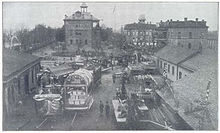Cotton States and International Exposition




The 1895 Cotton States and International Exposition was held at the current Piedmont Park in Atlanta, Georgia. Nearly 800,000 visitors attended the event. The exposition was designed to promote the region to the world and showcase products and new technologies as well as to encourage trade with Latin America. The Cotton States and International Exposition featured exhibits from several states including various innovations in agriculture and technology. President Grover Cleveland presided over the opening of the exposition. But the event is best remembered for the both hailed and criticized "Atlanta compromise" speech given by Booker T. Washington on September 18, promoting racial cooperation.
Overview
The Exposition was open for 100 days, beginning on September 18, 1895 and ending December 31, 1895, attracted visitors from the U.S. and 13 countries.[1] Over $2,000,000 was spent on the transformation of Piedmont Park.[2] The government allocated $250,000 for the construction of a government building and many states and countries such as Argentina also had their own buildings.[3] Also constructed for the fair were the Tropical gardens, now known as the Atlanta Botanical Garden, and Lake Clara Meer which was originally a pond but was expanded to 11.5 acres (47,000 m2) for the event.[4] Today, the stone balustrades scattered around the park are the only part of the enormous main building.[4] The park remains largely as Joseph Forsyth Johnson designed it for the exposition. The supervising architect for the entire fair was Bradford Gilbert.
Exhibits

The exposition included many exhibits in the categories of Minerals and Forestry, Agriculture, Food and Accessories, Machinery and Appliances, Horticulture, Machinery, Manufactures, Electricity, Fine Arts, Painting and Sculpture, Liberal Arts, Education and Literature. Pennsylvania's first woman American architect, Elise Mercur (1864–1947) design the Woman's Building of the Cotton States and International Exposition, a Palladian style building constructed for the purpose of displaying the accomplishments of women.[5] About six thousand exhibits were examined and beautifully designed medals were awarded. The Awards Committee awarded a total of 1,573 medals: 634 gold medals, 444 silver medals, and 495 bronze medals.[6] In late September Charles Francis Jenkins demonstrated an early movie projector called the "Phantoscope."
The great American band master John Philip Sousa composed his famous march, King Cotton, for the exposition, and dedicated it to the people of the state of Georgia.
Future politician and historian, Walter McElreath, described it in his memoirs:[7]
The railroad yards were jammed every morning with trains that brought enormous crowds. The streets were crowded all day long. Every conceivable kind of fakir bartered his wares. Dime museums flourished on every street.... Vast stucco hotels stood on Fourteenth Street.... I spent a great deal of time on the streets looking at the strange crowds -- American Indians, Circassians, Hindus, Japanese, and people from every corner of the globe -- who had come as professional midway entertainers or fakirs.
Negro Day
December 26, 1895, was Negro Day at the Expo.[8] Famed African American quilter Harriet Powers also attended this day and met with Irvine Garland Penn, the chief of the Negro Building at the Expo.[9]
Booker T. Washington's speech
The Cotton States and International Exposition Speech was an address on the topic of race relations given by Booker T. Washington on September 18, 1895, at the exposition in Atlanta. The speech laid the foundation for the Atlanta compromise, an agreement between African-American leaders and Southern white leaders in which Southern blacks would work meekly and submit to white political rule, while whites guaranteed that blacks would receive basic education and due process of law. The speech was presented before a predominantly white audience[10] and has been recognized as one of the most important, influential, and controversial speeches in American history.[11]
Legacy
After the exposition, the grounds were purchased by the City of Atlanta and became Piedmont Park and the Atlanta Botanical Garden.
Gallery
-
Map of the Expo
-
Lithograph of Piedmont Park plans for the 1895 World's Fair in Atlanta, GA
See also
- International Cotton Exposition, 1881 in Atlanta
- World Cotton Centennial, 1884 in New Orleans
References
33°47′05″N 84°22′30″W / 33.7848009°N 84.3751073°W
Notes
- ^ "Atlanta:Piedmont Park". Atlanta:A National Register of Historic Places Travel Itinerary. National Park Service. Retrieved 2008-06-05.
- ^ "FOR ATLANTA'S BIG SHOW" (PDF). New York Times Online. The New York Times. 1895-08-01. Retrieved 2008-06-05.
- ^ "Session 3: Address to the Country". The Progress of a People: A Special Presentation of the Daniel A. P. Murray Pamphlet Collection. Library of Congress. 1998-10-19. Retrieved 2008-06-05.
- ^ a b "Park History". Piedmont Park Conservancy. Archived from the original on 2007-05-04. Retrieved 2007-05-30.
- ^ Branton, Harriet (April 23, 1983). "Forgotten Lady Architect". Observer Reporter.
{{cite news}}:|access-date=requires|url=(help) - ^ "Exposition Medals". Medals of Atlanta Cotton States and International Exposition of 1895. Retrieved 2009-07-26.
{{cite news}}: Cite has empty unknown parameter:|coauthors=(help) - ^ McElreath, Walter, An Autobiography, Mercer University Press, p.129-130
- ^ "This is Negro Day," Atlanta Constitution December 26, 1895, p. 5
- ^ "This I Accomplish: Harriet Powers' Bible Quilt and Other Pieces, by Kyra E. Hicks, Black Threads Press, 2009, p. 40-41.
- ^ Text of Atlanta Compromise Speech
- ^ "Atlanta Compromise Speech". New Georgia Encyclopedia. Retrieved 2007-06-08.
Further reading
- Perdue, Theda. Race and the Atlanta Cotton States Exposition of 1895 (2010). detailed coverage



